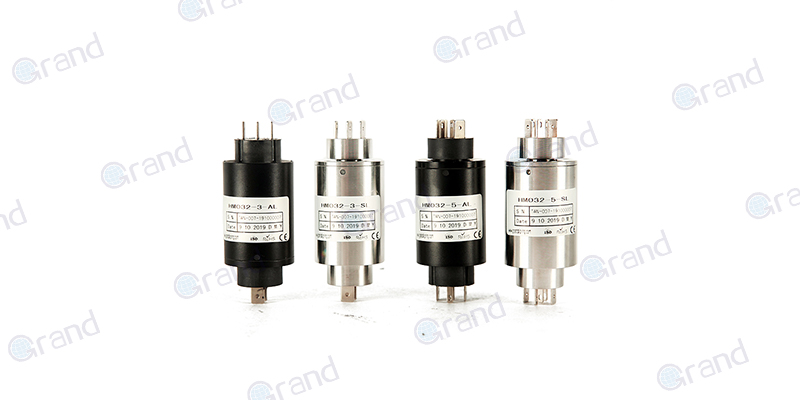In an era where precision and reliability are non-negotiable for advanced machinery, seamless signal transmission in rotating systems has become a cornerstone of modern technology. From radar systems tracking aircraft in real time to wind turbines optimizing energy generation, and robotic arms executing microsurgical procedures, the ability to maintain uninterrupted data or power flow between stationary and rotating components is critical. Any disruption in these systems can lead to catastrophic outcomes—data loss, operational downtime, or even safety hazards. At the heart of these applications lie rotary joints, specialized devices designed to bridge the gap between moving and static parts while preserving signal integrity.
This article aims to demystify the choice between two leading rotary joint technologies: fiber optic rotary joints (FORJs) and RF (radio frequency) rotary joints. While both serve the same fundamental purpose, their performance, cost, and suitability vary dramatically based on application requirements. By comparing their strengths, limitations, and real-world use cases, we empower engineers, system designers, and procurement professionals to make informed decisions tailored to their unique needs.
Key questions we’ll address include:
What are the pros and cons of fiber optic vs. RF rotary joints?
Which technology excels in bandwidth, durability, or EMI resistance?
How do factors like environment, budget, and scalability influence the choice?
Whether you’re upgrading legacy systems or designing cutting-edge solutions, understanding these distinctions ensures optimal performance, cost-efficiency, and future readiness for your projects. Let’s dive in.
What Are Rotary Joints?
Rotary joints, also known as rotary unions or slip rings, are electromechanical devices engineered to enable the continuous transfer of signals, power, or fluids between stationary and rotating components within a system. Unlike static connectors, they maintain uninterrupted connectivity even as one part spins—whether at slow speeds (e.g., wind turbines) or high velocities (e.g., radar antennas). These devices utilize precision-engineered contacts, optical channels, or waveguide interfaces to preserve signal integrity while accommodating 360-degree rotation.
How They Function
At their core, rotary joints consist of two main parts:
Stator: The stationary component fixed to the non-moving structure.
Rotor: The rotating part attached to the moving machinery.
Signals or power travel through interfaces (e.g., optical fibers, coaxial cables, or fluid channels) that remain aligned despite rotational motion. Advanced designs minimize friction, wear, and signal loss, ensuring long-term reliability.
Why They Matter:
Rotary joints are indispensable in industries where rotation and reliable data/power transmission coexist. Their failure can disrupt entire systems, leading to costly downtime or safety risks. Key sectors relying on rotary joints include:
Aerospace & Defense: Radar systems on military aircraft and naval ships require rotary joints to maintain real-time communication and targeting as antennas rotate. Satellite communication dishes also depend on them for uninterrupted signal transmission.
Medical Imaging: CT scanners and MRI machines use rotary joints to transmit high-resolution imaging data from spinning gantries to stationary computers, ensuring diagnostic accuracy.
Renewable Energy: Wind turbines rely on rotary joints to transfer power and sensor data from rotating blades to control systems, optimizing energy output and monitoring structural health.
Telecommunications: Satellite ground stations and broadcasting antennas use RF Rotary Joints to maintain signal continuity during directional adjustments.
Industrial Automation: Robotic arms in manufacturing plants depend on rotary joints to deliver power and control signals to rotating end-effectors.
In essence, rotary joints are the unsung heroes of motion-driven systems, enabling technologies that demand both precision movement and flawless connectivity. Their design complexity and material quality directly impact performance in extreme environments—whether resisting electromagnetic interference (EMI) in defense systems or enduring temperature fluctuations in industrial settings.
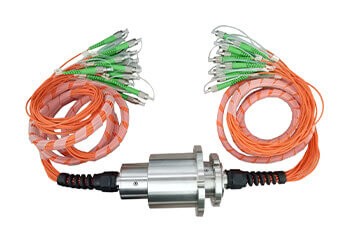
RF Rotary Joints
How They Work
RF (Radio Frequency) rotary joints transmit electromagnetic signals through coaxial cables or waveguide interfaces, maintaining connectivity between stationary and rotating components. These joints operate across a wide frequency spectrum, typically ranging from MHz to GHz bands (e.g., 2.4 GHz for Wi-Fi, 5–40 GHz for radar/satellite systems). The core mechanism ensures electrical continuity during rotation through precision-engineered conductive paths:
Coaxial-Based Designs: Use a central conductor surrounded by dielectric insulation and an outer shield. Sliding contacts or brush assemblies maintain signal integrity as the rotor turns.
Waveguide-Based Designs: Employ hollow metal tubes to guide high-frequency waves (e.g., X-band or Ka-band), often using choke joints or resonant cavities to minimize signal leakage.
Contactless Designs: Utilize inductive coupling or capacitive methods to reduce mechanical wear, ideal for high-speed or long-life applications.
Advantages
Robust Mechanical Design:
Built to withstand harsh environments, RF rotary joints excel in conditions with vibration, extreme temperatures, dust, or moisture. Stainless steel or aluminum housings enhance durability.Lower Initial Cost:
Simpler construction and widely available RF components make them more affordable than Fiber Optic Rotary Joints for basic setups (e.g., single-channel systems).Legacy System Compatibility:
Easily integrate with existing RF infrastructure (e.g., antennas, radios) without requiring signal converters or protocol changes.
Limitations
Susceptibility to EMI:
RF signals are vulnerable to electromagnetic interference from nearby motors, power lines, or other RF sources, potentially degrading performance.Bandwidth Constraints:
Coaxial systems typically max out at ~10 Gbps, limiting suitability for ultra-high-speed data (e.g., 8K video, hyperscale data centers).Frequency-Dependent Losses:
Higher frequencies (e.g., >20 GHz) experience greater attenuation over distance, necessitating signal boosters or repeaters.Impedance Mismatch Risks:
Poorly aligned connectors or damaged cables can cause signal reflections, leading to power loss and data errors.
Ideal Use Cases
Radar & Satellite Communication:
Rotating radar antennas (e.g., air traffic control, military surveillance) rely on RF joints for real-time tracking.
Satellite ground stations use waveguide-based joints to maintain uplink/downlink signals as dishes track orbital movements.
Industrial Automation:
Robotic arms with rotating sensors (e.g., torque, temperature) transmit data via RF joints in manufacturing lines.
Broadcasting:
TV/radio antennas use RF joints to adjust transmission angles without interrupting broadcast signals.
Wind Energy:
Monitor turbine blade conditions via rotating sensors connected to stationary control systems.
Technical Considerations
Frequency Range: Match the joint’s operational bandwidth (e.g., S-band for weather radar, Ku-band for satellite TV).
Environmental Protection: Opt for IP-rated or hermetically sealed joints in corrosive or outdoor settings.
Impedance Matching: Ensure 50-ohm or 75-ohm compatibility to prevent signal reflections.
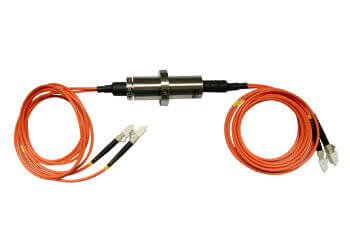
Head-to-Head Comparison
Below is a detailed breakdown of fiber optic rotary joints (FORJs) and RF rotary joints across critical performance and practical factors. Use this comparison to align your choice with specific operational, budgetary, and environmental needs.
Comparison Table
| Factor | Fiber Optic Rotary Joints | RF Rotary Joints |
|---|---|---|
| Bandwidth | Superior (Tbps range). Ideal for data-heavy tasks like 8K video, 5G, and cloud computing. | Limited (up to ~10 Gbps). Suitable for lower-bandwidth applications (e.g., radar, basic telemetry). |
| EMI Resistance | Immune to electromagnetic interference. Perfect for environments with motors, power lines, etc. | Susceptible to EMI. Requires shielding in noisy environments. |
| Durability | Sensitive to bending, vibration, and mechanical stress. Requires careful handling. | Robust construction (metal housings, sealed designs). Better for harsh, rugged environments. |
| Cost | Higher upfront costs (precision components, alignment). Long-term savings via lower maintenance. | Lower initial investment. Cost-effective for simple, low-bandwidth setups. |
| Installation Complexity | Requires skilled technicians for fiber alignment, splicing, and contamination control. | Plug-and-play integration with most RF systems. Minimal training needed. |
| Signal Security | Light signals are hard to intercept without physical tampering. Ideal for military/secure use. | RF signals can be intercepted or jammed. Less secure for sensitive data. |
| Scalability | Future-proof for rising data demands (e.g., IoT, 6G). Multi-channel designs support expansion. | Limited by frequency bandwidth and coaxial/waveguide constraints. Less adaptable to new tech. |
Key Takeaways
Bandwidth & Speed:
Fiber: Dominates in high-speed, high-volume data transmission (e.g., data centers, medical imaging).
RF: Sufficient for lower-data tasks (e.g., industrial sensors, basic telemetry).
Environment:
Fiber: Avoid in high-vibration or dusty settings unless ruggedized.
RF: Thrives in harsh conditions (e.g., offshore rigs, factory floors).
Cost vs. ROI:
Fiber: Higher initial cost but lower lifecycle expenses (minimal signal loss, fewer repeaters).
RF: Budget-friendly for simple, short-term projects but may require upgrades for scalability.
Security:
Fiber: Mandatory for defense, finance, or healthcare applications.
RF: Acceptable for non-sensitive public systems (e.g., broadcasting antennas).
When to Choose Which?
Opt for Fiber Optic Rotary Joints if:
You need ultra-high bandwidth and EMI immunity.
Long-distance signal integrity is critical.
Security and future scalability are priorities.
Opt for RF Rotary Joints if:
Operating in physically demanding environments.
Budget constraints favor lower upfront costs.
Legacy RF systems are already in place.
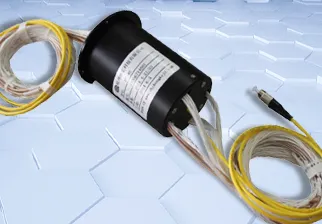
User-Centric Decision Guide
Choosing between fiber optic and RF rotary joints hinges on aligning technology strengths with your project’s unique demands. Below is a step-by-step framework to guide your decision:
Ask These Questions
What’s your signal type?
Analog RF Signals: RF rotary joints are optimized for traditional radio frequency applications like radar, radio broadcasting, or analog sensor data.
Digital/Data-Heavy Signals: Fiber optic joints excel in transmitting high-speed digital data (e.g., video streams, encrypted communications, or IoT sensor networks).
What’s your operational environment?
Harsh Conditions (vibration, dust, moisture): RF joints, with rugged metal housings and sealed designs, outperform delicate fiber optics.
EMI-Heavy Settings (near motors, power lines): Fiber’s immunity to electromagnetic interference ensures stable performance.
Controlled Environments (labs, data centers): Either technology works, but fiber maximizes speed and security.
What’s your budget?
Initial Costs: RF joints are cheaper upfront for simple, low-bandwidth setups.
Lifecycle Costs: Fiber offers long-term savings via minimal signal loss, reduced repeaters, and lower maintenance.
Do you need future scalability?
Upgrading Bandwidth: Fiber’s terabit capacity supports evolving needs (e.g., 6G, AI-driven analytics).
Legacy Systems: RF suits projects with existing coaxial/waveguide infrastructure and no near-term upgrades.
Recommendations
Choose Fiber Optic Rotary Joints If:
Your application demands ultra-high bandwidth (e.g., 8K video broadcasting, real-time medical imaging).
EMI resistance is non-negotiable (e.g., military communications, industrial automation near heavy machinery).
Signal security is critical (e.g., financial data centers, classified defense systems).
You prioritize future-proofing for emerging technologies.
Choose RF Rotary Joints If:
Cost efficiency is a priority for short-term or low-data projects (e.g., basic telemetry, rotating antennas).
The environment is physically demanding (e.g., offshore wind turbines, factory robots).
You’re integrating with legacy RF systems (e.g., radio towers, analog sensors).
Decision Flowchart Concept
Start with signal type → Digital? Lean toward fiber. Analog? Consider RF.
Evaluate environmental risks → Harsh? Choose RF. EMI-heavy? Choose fiber.
Weigh budget constraints → Tight initial budget? RF. Long-term ROI focus? Fiber.
Assess scalability needs → Future upgrades planned? Fiber. Static requirements? RF.
This guide transforms technical specifications into actionable insights, empowering users to make confident, context-driven decisions. Addressing real-world constraints and goals bridges the gap between theory and practical implementation.
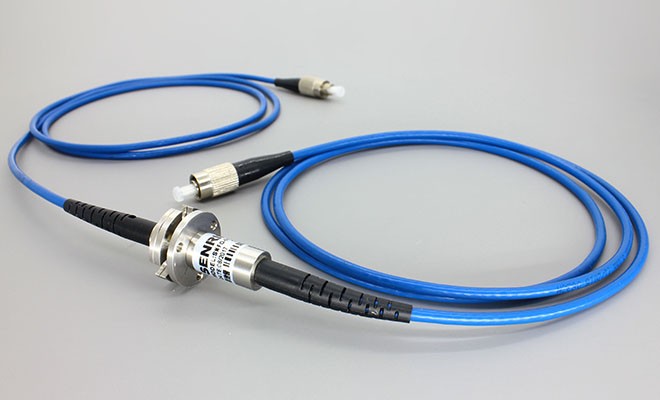
Real-World Case Studies
Case 1: Military Radar System Upgrading from RF to Fiber for Secure, High-Speed Data
Background:
A naval defense contractor operating a legacy radar system faced challenges with signal interception and bandwidth limitations. The existing RF rotary joints struggled to handle modern encrypted targeting data and were vulnerable to EMI from onboard electronic warfare systems.
Solution:
The system was upgraded with multi-channel fiber optic rotary joints (FORJs). Key improvements included:
Enhanced Security: Light-based signals prevented eavesdropping, critical for encrypted communications.
Higher Bandwidth: Enabled real-time transmission of high-resolution radar imagery and targeting data (up to 40 Gbps).
EMI Immunity: Eliminated interference from shipboard radars and communication systems.
Challenges:
Retrofitting fiber optics into existing RF infrastructure required modular adapters.
Training personnel on fiber handling and maintenance protocols.
Outcome:
50% faster data processing for threat detection.
Reduced downtime caused by signal degradation.
Future-proofed for integration with AI-driven threat analysis systems.
Case 2: Industrial Robot Using RF Joints for Reliable Low-Cost Signal Transmission
Background:
An automotive manufacturer needed a cost-effective solution for a robotic welding arm requiring continuous rotation. The robot’s sensors and control signals operated in a high-vibration, dusty factory environment.
Solution:
Ruggedized RF rotary joints were deployed due to their:
Durability: Stainless steel housing resisted mechanical stress and particulate contamination.
Cost Efficiency: 30% lower upfront cost compared to fiber optics.
Compatibility: Seamless integration with existing analog sensors and PLCs.
Challenges:
Signal noise from nearby welding equipment required additional shielding.
Limited bandwidth restricted data streams to basic telemetry (no video feeds).
Outcome:
99.8% operational uptime over 12 months.
Achieved ROI within 6 months due to minimal maintenance.
Scalable for replicating across 50+ identical robots in the production line.
Key Lessons
Fiber Optics: Prioritize for high-security, high-bandwidth upgrades in controlled or EMI-heavy environments.
RF Joints: Ideal for cost-sensitive, rugged applications where data demands are modest.
These case studies underscore how context-specific factors—security, environment, and scalability—drive technology choices, offering readers tangible examples to inform their own projects.


